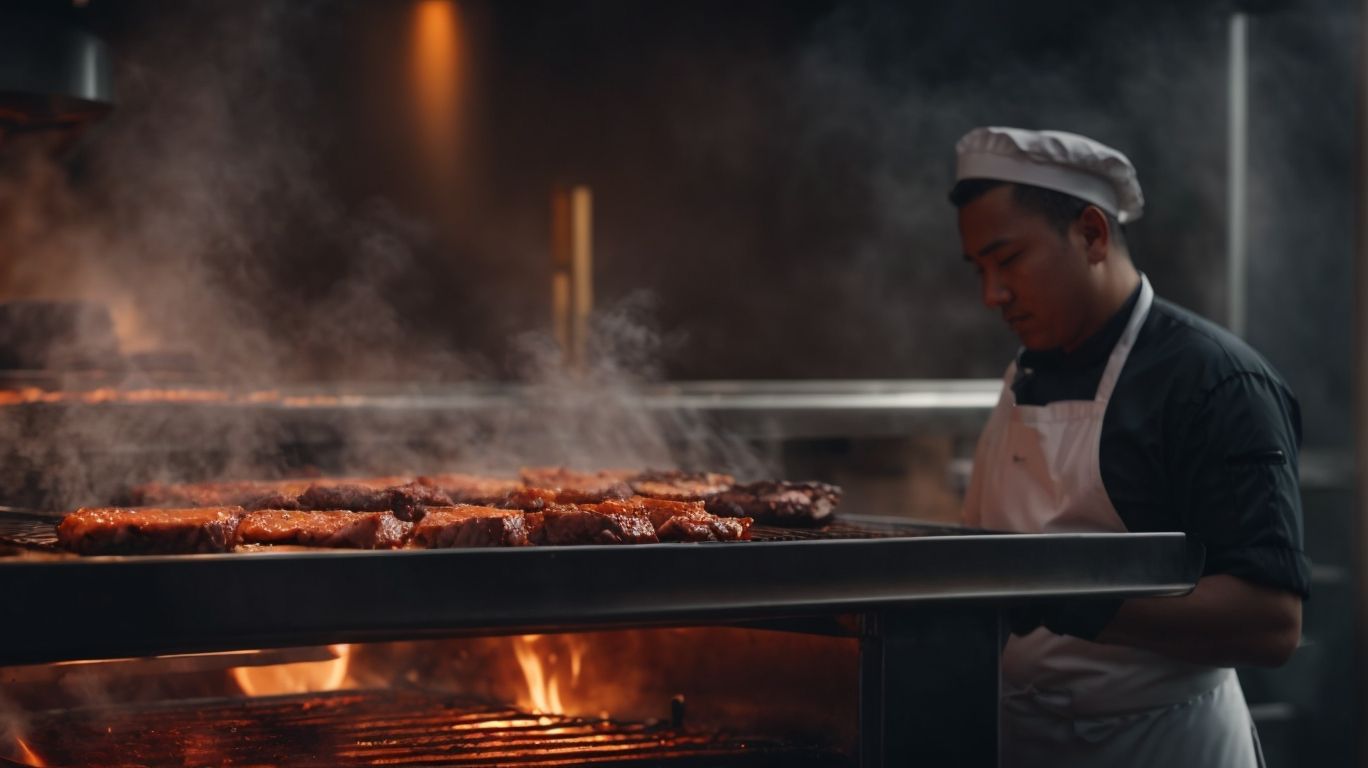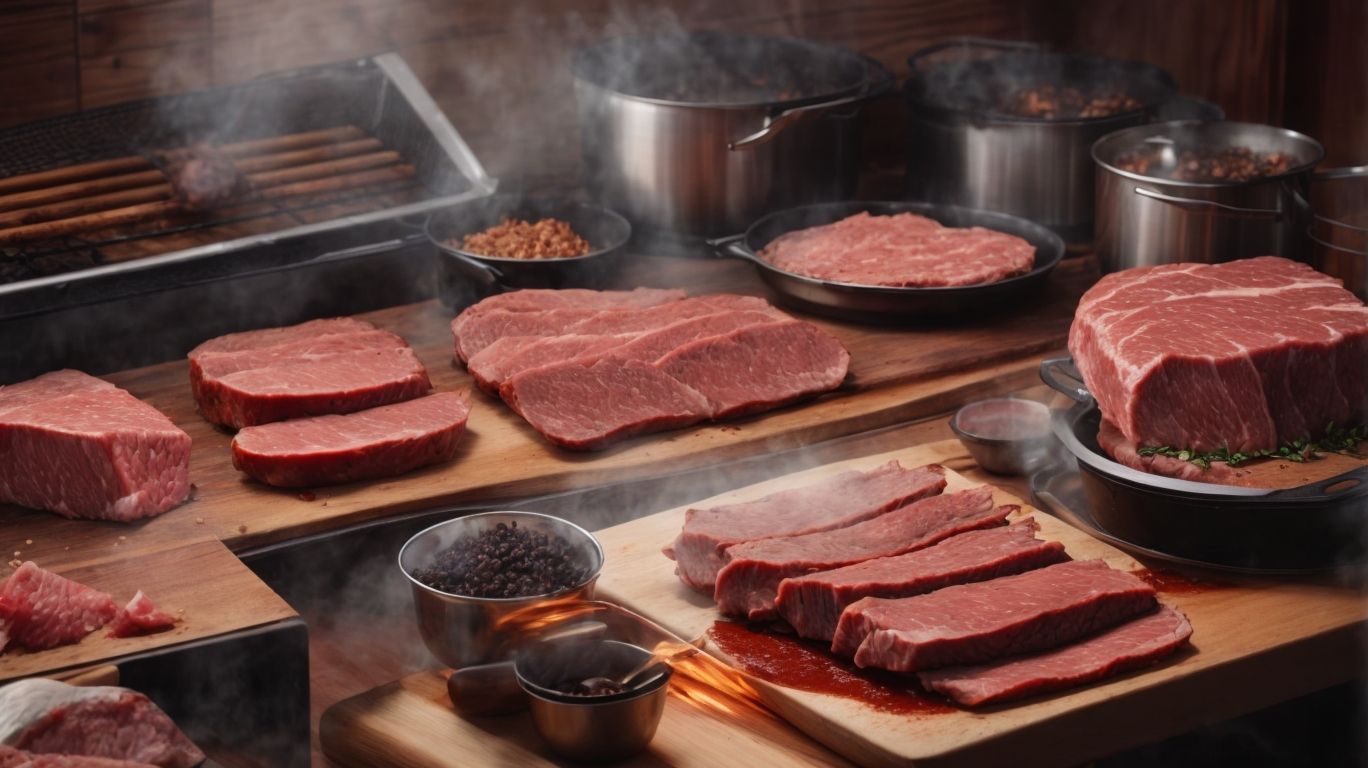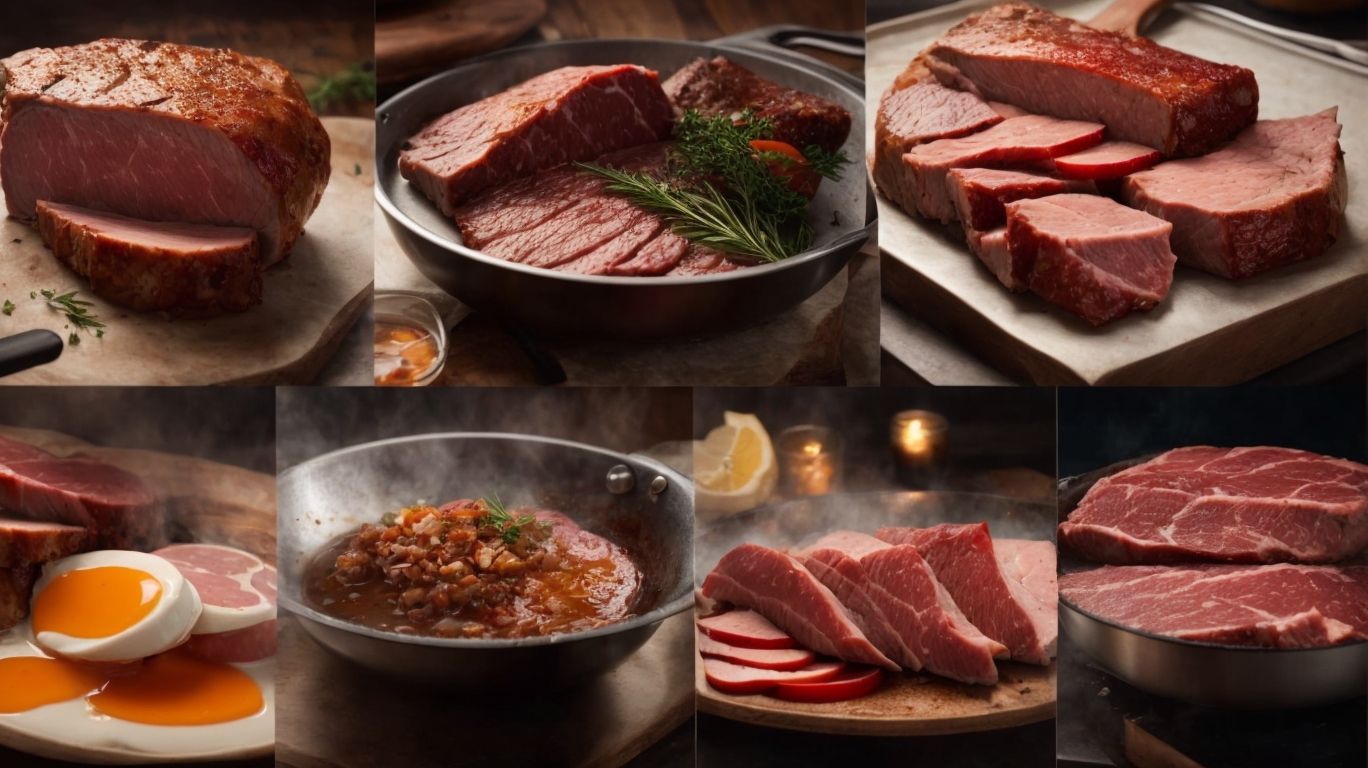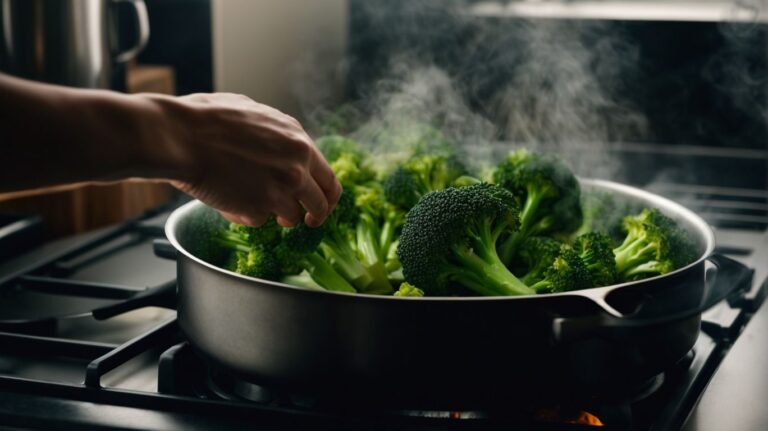How to Cook Meat Step by Step?
Are you a meat lover looking to up your culinary game? In this guide, we will explore the different types of meat, cuts, preparation techniques, cooking methods, and tips to help you cook the perfect meat every time. From beef to seafood, roasts to steaks, grilling to slow cooking, we’ve got you covered. Whether you’re a seasoned chef or a beginner in the kitchen, this article will take you step by step through the process of cooking meat like a pro. Let’s dive in!
Key Takeaways:
What Are the Different Types of Meat?
Meat comes in various types, including beef, pork, poultry, lamb, and seafood, each offering unique flavors and cooking characteristics.
Beef, known for its rich flavor and juicy texture, is versatile and can be cooked in various ways such as grilling, roasting, or braising. It’s essential to be mindful of the cut when cooking beef, as different cuts require different cooking techniques.
Pork, on the other hand, is prized for its tenderness and subtle sweetness. Popular pork dishes include pulled pork, pork chops, and pork tenderloin. Pork can be fried, grilled, roasted, or even smoked to enhance its flavor.
Poultry, including chicken and turkey, offers a wide range of options from lean cuts to dark meat. Chicken breasts are known for their mild flavor and versatility, while chicken thighs are more flavorful and juicy. Turkey is often roasted whole for holidays, but can also be grilled or fried for a twist on traditional dishes.
Lamb is distinctive for its bold, rich flavor and tender texture. Lamb chops and racks are popular cuts that are best cooked quickly over high heat, while lamb shanks benefit from slow cooking methods like braising. Lamb pairs well with robust herbs and spices, bringing out its unique taste.
Seafood, ranging from fish to shellfish, offers a variety of flavors and textures. Fish like salmon and tuna are rich and meaty, perfect for grilling or pan-searing. Shrimp and scallops are delicate and sweet, great for quick sautéing or grilling. Seafood is often cooked quickly to preserve its delicate texture and natural flavors. Each type of meat requires different cooking techniques to bring out its best qualities and flavors, making them a versatile and delicious addition to any meal.
Beef
Beef is a popular meat choice that can be prepared in various ways such as roasting, grilling, or searing to enhance its rich flavor and marbling.
In terms of different cuts of beef, each offers a unique texture and taste profile. From the tenderloin to the ribeye, there’s a cut for every preference, whether you prefer a leaner option or one with more marbling.
Besides the cut, the cooking method also plays a crucial role in bringing out the best in beef. Whether slow-cooking a brisket for hours to achieve a melt-in-your-mouth texture or quickly searing a sirloin steak for a delicious crust, the technique can make all the difference in the final dish.
To further elevate the flavor of beef, mastering the art of seasoning is essential. Whether using a simple combination of salt and pepper to let the natural beef flavor shine through or experimenting with bold spice blends, the seasoning can complement the marbling and enhance the overall taste experience.
Pork
Pork offers a versatile range of cuts, including chops and shoulder, which can be tenderized and cooked slowly in a slow cooker with flavorful seasonings.
For example, pork chops are quick to cook and can be pan-fried, grilled, or even breaded and fried for a crispy texture. On the other hand, pork shoulder is known for its tenderness when braised or slow-cooked, making it perfect for dishes like pulled pork or stews.
Slow cooking pork cuts not only helps to tenderize the meat but also allows the flavors to develop and marry together for a rich and delicious taste. By using a good blend of seasonings such as garlic, paprika, thyme, and herbs like rosemary, you can enhance the natural flavors of the pork while creating a depth of taste that is irresistible.
Poultry
Poultry, such as chicken, can be roasted to perfection with marinades and seasonings, ensuring it reaches the correct internal temperature for safe consumption.
Cooking poultry involves several key steps to guarantee a delicious and safe meal.
- Marinating the chicken before cooking can enhance flavor and tenderness by allowing the meat to absorb the flavors of the marinade.
- Seasoning the poultry with a blend of herbs and spices not only adds depth to the taste but also creates a flavorful crust when roasted.
- Monitoring the internal temperature throughout the cooking process is crucial to ensure that the chicken is thoroughly cooked and safe to eat.
By following these steps, you can create a memorable poultry dish that is both delicious and safe to enjoy.
Lamb
Lamb is a flavorful meat that benefits from braising with aromatic ingredients like wine and citrus to enhance its tenderness and taste.
When cooking lamb, it is essential to choose the right cuts, such as shoulder or leg, for braising to achieve optimal results. The process of braising involves searing the meat to develop a flavorful crust and then slow-cooking it in a liquid, often a combination of wine and citrus, until it becomes fork-tender. This method not only infuses the meat with rich flavors but also helps break down the connective tissues, resulting in a tender and succulent dish.
Marinating the lamb in a mixture of herbs, spices, and acidic ingredients can further enhance its tenderness and flavor profile. By incorporating these techniques, you can elevate your lamb dishes to new heights of deliciousness.
Seafood
Seafood offers a delicate flavor profile that can be enhanced through browning techniques and various cooking methods like baking or grilling.
When browning seafood, ensure that the pan is hot before adding the fish or shellfish to achieve a caramelized exterior and intensify the flavors.
For baking seafood, consider marinating the proteins beforehand to infuse deeper flavors, then bake at a moderate temperature to keep the texture moist and tender.
Alternatively, grilling seafood is a quick and flavorful method that adds a smoky essence; remember to oil the grill grates to prevent sticking and provide those coveted grill marks.
What Are the Different Cuts of Meat?
Meat can be found in a variety of cuts, from roasts and steaks to chops and ground meat, each requiring specific cooking techniques for optimal results.
Roasts, such as sirloin or brisket, are ideal for slow cooking methods like braising or roasting, which help tenderize the meat and enhance its flavors.
On the other hand, steaks like ribeye or filet mignon are best cooked using high heat methods such as grilling or pan-searing to achieve a delectable sear on the outside while keeping the inside tender and juicy.
Chops, such as pork chops or lamb chops, are perfect for quick cooking methods like pan-frying or grilling, providing a deliciously crispy exterior and juicy interior.
In terms of ground meat, whether beef, chicken, or turkey, it’s versatile and cooks quickly, making it suitable for dishes like burgers, meatballs, or tacos.
Roasts
Roasts are large cuts of meat that are typically cooked in the oven, seasoned with herbs and spices, and seared for a flavorful outer crust.
There are various types of roasts depending on the part of the animal they come from, such as prime rib, pork loin, or leg of lamb. Each type requires a specific cooking method to bring out its best flavors and textures. When oven-roasting, it’s essential to preheat the oven to the right temperature and use a meat thermometer to ensure perfect doneness. Seasoning your roast with a mix of salt, pepper, and rosemary can elevate its taste profile. Searing the meat before baking not only enhances flavor but also helps to lock in juices for a moist and tender result.
Steaks
Steaks are tender cuts of meat that are ideal for pan-frying to achieve a delicious crust while ensuring the internal temperature reaches the desired level.
There are various types of steaks available, such as ribeye, sirloin, T-bone, and filet mignon, each offering a unique taste and texture. When pan-frying steaks, it is crucial to preheat the pan properly and sear the meat on high heat to seal in the juices. Constantly monitoring the internal temperature with a meat thermometer is essential to avoid overcooking or undercooking the steak. Different levels of doneness can be achieved by monitoring the internal temperature, with rare steaks typically around 125°F, medium at 145°F, and well-done at 160°F.
Chops
Chops, whether from pork or other lean meats, can be seasoned and browned to perfection for a delicious and tender dining experience.
There are various types of chops, including pork chops, lamb chops, and veal chops, each offering its unique flavor profile and texture. In terms of seasoning, options are versatile, ranging from simple salt and pepper to elaborate spice rubs or marinades to enhance the natural taste of the meat.
For browning, different methods like pan-searing, grilling, or broiling can be employed, depending on the desired outcome. Achieving a golden crust while maintaining the juiciness inside is essential for a flavorful chop.
Experiment with seasoning blends and browning techniques to discover your favorite combination for a mouthwatering chop.
Ground Meat
Ground meat, such as beef or pork, is versatile and can be seasoned and grilled for a variety of dishes, offering a convenient option for many recipes.
Seasoning options for ground meat range from classic combinations like salt, pepper, and garlic to more adventurous blends like cumin, paprika, and chili powder, allowing you to customize the flavor profile to suit your preferences.
When grilling ground meat for dishes like burgers or meatballs, it’s essential to shape the patties or balls evenly to ensure even cooking. Maintaining a medium-high heat on the grill helps achieve a delicious caramelized exterior while keeping the inside juicy and flavorful.
How to Properly Prepare Meat for Cooking?
Properly preparing meat for cooking involves steps like thawing, seasoning, and tenderizing to enhance its flavor and texture before cooking.
Thawing meat safely is crucial to avoid any risk of bacterial contamination. The most recommended method is to place the meat in the refrigerator for slow and safe thawing. This process helps maintain the meat’s quality.
In terms of seasoning, incorporating a mix of herbs, spices, and marinades can add layers of flavor to the meat. For tougher cuts, tenderizing techniques such as using a meat mallet or marinating with acidic ingredients can break down the meat fibers, resulting in a more tender and juicy outcome.
Thawing Meat
Thawing meat properly is essential for food safety and can be done in the refrigerator, cold water, or using a microwave for convenience.
When thawing meat in the refrigerator, it is important to place the meat on a plate or in a container to prevent any drippings from contaminating other food items. Allow plenty of time as this method can take several hours, depending on the size of the meat. Safe thawing practices involve keeping the meat at a constant, safe temperature to inhibit bacteria growth.
Alternatively, cold water submersion involves placing the meat in a sealed bag and submerging it in cold water, changing the water every 30 minutes to ensure it stays cold. This method can be quicker than refrigeration but requires close monitoring to prevent the water from reaching room temperature, which can lead to bacteria growth.
The microwave method is the fastest but requires caution as it can lead to uneven thawing. Use the defrost setting and follow the microwave’s instructions to avoid partially cooking the meat. Remember, it’s crucial to cook the meat immediately after thawing when using this method to prevent foodborne illnesses.
Seasoning Meat
Seasoning meat with a mix of spices and marinades enhances its flavor profile, creating a delicious and memorable dining experience.
Experimenting with different combinations of spices such as cumin, paprika, and garlic powder can elevate the taste of your meat dishes to a whole new level. A well-balanced marinade not only adds flavor but also tenderizes the meat, making it juicier and more succulent. The duration of marinating is crucial as it allows the flavors to penetrate the meat fully. Consider marinating overnight for richer flavors or opting for a quick marinade for a hint of seasoning.
Tenderizing Meat
Tenderizing meat breaks down connective tissue and tough muscle fibers, resulting in a more tender and enjoyable eating experience.
Tenderizing meat involves various methods to achieve the desired tenderness. One common technique is mechanical tenderizing, where the meat is pounded or pierced with a tool to break down tough fibers. This process physically disrupts the muscle structure, making it easier to chew and digest.
Another method is marinating meat with acidic ingredients like lemon juice, vinegar, or yogurt. The acids help to denature proteins in the meat, softening it by breaking down the connective tissue and enhancing flavor penetration.
What Are the Different Cooking Methods for Meat?
Cooking meat can be done through various methods like grilling, roasting, pan-frying, braising, or slow cooking, each imparting unique flavors and textures to the dish.
Grilling involves cooking meat over direct heat, usually on a grill or barbecue. This method is great for achieving those sought-after grill marks and that smoky flavor.
Roasting, on the other hand, requires cooking in an oven at a consistent temperature, resulting in a juicy and tender outcome.
Pan-frying entails cooking meat in a hot pan with some oil, producing a crispy exterior while locking in the juices.
Braising involves a combination of searing and slow cooking in liquid, ensuring a flavorful and succulent dish.
Slow cooking, as the name suggests, requires long hours of low-temperature cooking, ideal for tough cuts of meat that become tender and full of flavor over time.
Grilling
Grilling meat over an open flame imparts a smoky and flavorful taste, making it a popular choice for cooking steaks, poultry, and other meats.
When grilling meat, the heat source plays a crucial role in achieving the perfect cook. Whether you opt for charcoal, gas, or wood pellets, each imparts a distinct flavor profile. Heat control is key to preventing overcooking or uneven doneness. The searing effect from direct heat helps lock in juices, creating a caramelized outer layer.
Flavor development is enhanced through marinades, rubs, and sauces that infuse your meat with zestful tastes. Maillard reaction is a fundamental process during grilling, where proteins and sugars react to create the desirable brown crust.
Roasting
Roasting meat in the oven results in a succulent and tender dish, perfect for preparing dishes like roast chicken, which benefits from marinating and reaching the correct internal temperature.
When roasting meat, it is essential to preheat the oven to around 350-450°F, depending on the type of meat and desired doneness. Marinating the meat beforehand not only enhances flavor but also helps tenderize it. The marination process allows the flavors to penetrate deep into the meat, resulting in a more flavorful end product. Monitoring the internal temperature with a meat thermometer is crucial to ensuring that the meat is cooked to perfection. This ensures that the meat is safe to eat while preserving its juiciness and tenderness.
Pan-frying
Pan-frying meat in a cast-iron skillet with oil results in a crispy outer layer and juicy interior, making it ideal for cuts like pork shoulder that benefit from browning.
When selecting the oil for pan-frying, it is crucial to choose options with high smoke points, such as vegetable oil, canola oil, or grapeseed oil, to prevent burning and achieve a beautiful sear. Heat your cast-iron skillet over medium-high heat before adding the oil to ensure even cooking. The browning process, known as the Maillard reaction, elevates the flavor profile by creating caramelization and a savory crust on the meat while locking in moisture. Keep the meat in constant motion to avoid sticking and achieve an evenly browned surface.
Braising
Braising meat involves slow cooking in a flavorful liquid to break down connective tissue, making tough cuts like shoulder tender and succulent, especially when using wine for added depth.
When preparing a braised dish, it’s essential to select the right type of meat, typically tougher cuts such as pork shoulder, beef chuck, or lamb shank. These cuts have high levels of connective tissue, which when cooked slowly, transforms into rich, melt-in-your-mouth texture.
The choice of liquid for braising can vary from broth and wine to beer or even fruit juices, each adding its unique flavor profile to the dish. The liquid not only provides moisture for cooking but also infuses the meat with aromatic essences during the long, gentle simmering process.
The cooking time for braising depends on the size and thickness of the meat pieces. Generally, a low temperature and a longer cooking period are favored to ensure the connective tissues properly break down, resulting in a fork-tender outcome.
Slow Cooking
Slow cooking meat over a low temperature allows it to simmer and roast slowly, resulting in tender and flavorful dishes that benefit from marinating beforehand.
When meat is slow-cooked, the low temperature helps break down tough connective tissues, transforming the protein into succulent bites that practically melt in your mouth. This process not only results in juicy and tender meat but also extracts the maximum amount of flavor from the ingredients.
Long, slow cooking allows the flavors to meld together harmoniously, creating a depth of taste that is unmatched by quicker cooking methods. Marinating the meat before cooking enhances the final dish with an infusion of spices, herbs, and seasonings, elevating the overall taste profile.
How to Know When Meat is Cooked?
Determining when meat is cooked involves using a meat thermometer to check the internal temperature or relying on visual cues like color and texture to ensure doneness.
Using a meat thermometer is one of the most accurate ways to ensure your meat is cooked correctly. Insert the thermometer into the thickest part of the meat without touching any bone, and make sure it reaches the deepest point for an accurate reading. Beef should reach at least 145°F (63°C), poultry 165°F (74°C), and pork 145°F (63°C).
- Alternatively, you can rely on visual cues such as the color change; for example, a pink hue in chicken juices indicates it needs more time while clear juices show doneness.
- Texture can also be a good indicator. Meat that is firm and springs back when touched is usually cooked well.
- Combining both methods can give you the most precise result.
Using a Meat Thermometer
Using a meat thermometer is the most reliable way to ensure meat reaches the correct internal temperature for safe consumption, promoting proper food safety practices.
It is crucial to understand that different types of meat require specific internal temperatures to be safe for consumption. By using a meat thermometer, you can accurately monitor the doneness of various meats, including beef, poultry, pork, and seafood.
Temperature precision is essential to kill harmful bacteria that can cause foodborne illnesses. Without a meat thermometer, it is challenging to determine if meat has reached the recommended temperature, increasing the risk of serving undercooked food.
Visual Cues
Visual cues like browning, searing, and roasting can indicate when meat is cooked to the desired level, providing a visual guide for determining doneness.
When meat is properly cooked, a well-done steak will typically have a dark brown sear on the outside, while medium-rare meat might display a pinkish hue in the center. Roasting a whole chicken or turkey until the skin is golden and crispy can also signify readiness. Juices running clear instead of pink when pierced with a fork can be another key indicator of doneness, ensuring that your dish is cooked to perfection.
Tips for Cooking the Perfect Meat

Credits: Poormet.Com – Bobby Brown
To cook the perfect meat, consider tips like proper seasoning, browning for flavor development, and using the right cooking techniques to enhance the overall taste and texture.
In terms of seasoning, salt is a key element but don’t overlook the power of other herbs and spices, such as pepper, garlic powder, or rosemary, to elevate the flavor profile.
For browning your meat, ensure your pan is hot enough before adding the meat to achieve that delicious caramelization without steaming the meat instead.
Depending on the cut, consider grilling, roasting, braising, or sous vide methods to achieve the desired doneness and texture for your dish.
Conclusion

Credits: Poormet.Com – William Clark
Mastering the art of cooking meat involves understanding different types of meat, cuts, preparation methods, cooking techniques, and ensuring proper food safety practices for a delightful dining experience.
In terms of diverse meat types, it’s important to consider the unique flavor profiles and textures that each type offers. Whether it’s juicy steaks, tender pork chops, or succulent chicken breasts, knowing how to handle and season each kind of meat can greatly enhance the final dish. Preparation methods play a crucial role in ensuring the meat is tender and flavorful. Marinating, brining, and seasoning are key steps that can make a significant difference in taste and texture.
- Choosing the right cooking techniques is equally vital. From grilling and roasting to braising and pan-searing, each method imparts its own distinct flavors and textures to the meat. Proper cooking times and temperatures are essential to retain the juiciness and tenderness of the meat while ensuring it is cooked thoroughly to avoid any foodborne illnesses.
Frequently Asked Questions
What are the essential steps for cooking meat perfectly?
The key to cooking meat perfectly is to follow a few crucial steps. First, make sure to choose the right cut of meat for your desired dish. Then, season the meat with your preferred spices and let it sit for a few minutes. Next, preheat your pan or grill and ensure that it’s at the right temperature. Lastly, follow the cooking time guidelines for your specific type of meat.
What are some tips for tenderizing tough cuts of meat?
Tough cuts of meat require some extra attention to become tender and juicy. One tip is to marinate the meat for a few hours before cooking. Another option is to use a meat tenderizer tool to break down the tough fibers. Slow cooking methods, such as braising or stewing, can also help tenderize tough cuts of meat.
How do I know when my meat is cooked to the right temperature?
The best way to determine if your meat is cooked to the right temperature is by using a meat thermometer. Different types of meat have different internal temperature guidelines, so it’s essential to have a reliable thermometer on hand. Additionally, you can also check the meat’s color and texture to see if it’s cooked to your liking.
What are some common mistakes to avoid when cooking meat?
One of the most common mistakes people make when cooking meat is not allowing it to rest after cooking. Letting the meat rest for about 5-10 minutes will help the juices redistribute, resulting in a more tender and flavorful dish. Another mistake is overcooking the meat, which can lead to a dry and tough texture.
Can I use the same cooking method for all types of meat?
While many cooking methods can work for different types of meat, it’s important to consider the specific cut and thickness of the meat. For example, a thick steak may require a different cooking time than a thin chicken breast. It’s best to research and follow guidelines for each type of meat to ensure the best results.
What are some alternative methods for cooking meat?
Aside from traditional methods like grilling or roasting, there are several alternative ways to cook meat. One option is to use a slow cooker or pressure cooker for tender and flavorful dishes. Another unique method is to smoke meat, which adds a smoky flavor and tenderizes the meat. You can also try sous vide cooking, where the meat is cooked in a vacuum-sealed bag in a water bath.






